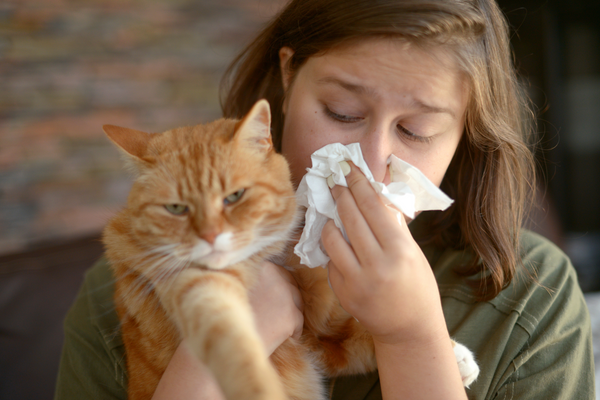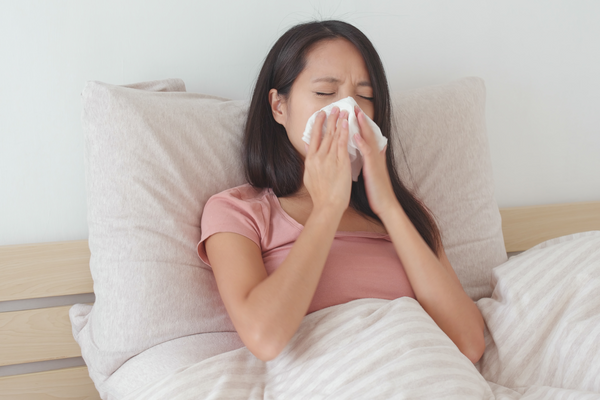Dust Mite Allergies in Dogs: How To Reduce Allergens & Give Your Dog Relief

Our canine companions can suffer from allergies just as we do, from different foods (grain, corn, fish, chicken, beef, and more), fleas, pollen, molds, dander, and even dust mites. Dust mites are microscopic spider-like creatures that live in our homes and feed on the flakes of dead skin that people and animals shed every day. These tiny mites live in household items like bedding, sofas, carpets, curtains, and pet bedding and release a type of protein in their body parts and waste that can cause a reaction in those who are allergic.
Dust mites are the most common household allergen for humans – but they can also impact the health of our pets. According to Dr. Ashley Rossman, DVM, CVA, “Dust mite allergies are more common than you think. In fact, dust mites, molds, and pollens are the three major airborne allergens that pets are susceptible to.” Due to their microscopic size, many people don’t realize that dust mites can cause such a problem. However, throughout its lifetime, a single mite can produce up to 200 times its own body weight in waste, which, if left unaddressed, can accumulate extraordinarily quickly, triggering ongoing allergic reactions in those who are allergic or particularly sensitive to mites. Although it’s impossible to eliminate dust mites from your home completely, there are several excellent methods you can use to drastically reduce their numbers and neutralize their threat.
Common Symptoms of Dust Mite Allergies in Dogs
Dust mite allergies in dogs are caused by the body parts and feces of dust mites. If your dog has been having symptoms year-round and seems to breathe better outdoors, you might suspect dust mite allergies. Your veterinarian will consider a range of factors to decide whether or not dust mites are the culprit to your dog’s allergies and may perform tests to confirm the diagnosis.
Dogs of any breed, gender, and age can be affected by dust mite allergies. Still, dust mite allergies are most frequently seen in dogs over three months old, English Bulldogs, French Bulldogs, German Shepherds, Miniature Schnauzers, Pugs, Retrievers, Setters, and Terriers.
Symptoms of Dust Mite Allergies in Dogs May Include:
- Excessive scratching
- Excessive licking
- Sneezing
- Coughing
- Redness and watering of the eyes and nose
- Skin inflammation and irritation
- Ear infections
- Vomiting
- Diarrhea
If your dog has a severe reaction to dust mites, the response may also produce airway inflammation (anaphylaxis) and cause a constriction that makes it hard to breathe. If you notice your dog sneezing, coughing, and wheezing, consult your veterinarian right away.
Minimizing Dust Mite Allergens in Your Home
While it’s not possible to completely free your home of dust mites, there are plenty of things you can do to reduce the number of dust mites and their allergens in your home:
1. Up Your Cleaning Game
It’s important to note that dust mites will live in even the cleanest of homes! However, maintaining a frequent cleaning schedule is crucial, with the average human shedding enough dead skin every day to feed one million of these pesky little critters. Aim to clean and remove dust at least twice a week. Rather than using a dry dusting method that can cause the allergen to go airborne, use a damp microfiber cloth to remove dust from furniture, shelves, windowsills, and other dust-prone areas around your home.
For extra dust mite-busting power, reach for an Anti-Allergen Solution. You can either spray it directly onto hard surfaces after cleaning to neutralize dust mite allergens or spray it onto a microfiber cloth and wipe. This solution can be used on both hard and soft surfaces. The Anti-Allergen Solution renders common household allergens – including dust mite allergens and pet dander – harmless to allergy sufferers.
Related: Have Pets? Consider Ditching These Chemicals
2. Frequently Vacuum Rugs, Carpets, & Upholstery
If Fido is allergic to dust mites, thoroughly vacuuming carpets, rugs, and upholstery frequently (ideally two to three times a week) will help to reduce dust mite populations. However, to actually capture dust (as well as pet dander and other airborne allergens), be sure to use a vacuum with a sealed high-efficiency particulate air (HEPA) filter. HEPA filters work by trapping tiny particles in the fine mesh, including dust, pollen, and even tobacco smoke. Regular vacuums will only suck up big pieces of dust and may even send tiny microscopic particles flying right back out into the air, triggering allergy and asthma symptoms. According to the Environmental Protection Agency (EPA), HEPA filters can capture more than 99% of particles at least 0.3 microns in size and prevent them from being released back into the air.
After vacuuming, spray carpets, rugs, and upholstery with our DustmiteX Solution to eliminate any remaining dust mites and their allergens.
3. Routinely Deep Clean Rugs, Carpets & Upholstery
Deep cleaning should be done at least twice per year to keep carpets and upholstery clean and healthy. After thoroughly vacuuming with a HEPA vacuum, use a carpet cleaner (or hot water extractor) along with our Dustmite & Flea Control to help keep dust mites (and fleas!) from coming back. Dustmite & Flea Control can be applied directly to surfaces or mixed with water; it was designed to work well with hot water vacuums. Hot water extraction has the added benefit of reducing more allergens, as dust mite allergens are water-soluble. When using a carpet cleaner or hot water extractor, always follow the manufacturer’s instructions on cleaning for best results.
Dustmite & Flea Control works by coating the mite’s food source and essentially starves them, so populations die off. This is great news for allergy sufferers since killing mites gets right to the allergen source. With dust mites eliminated, they can no longer produce particles that contribute to your dog’s symptoms. Remember that dust mites thrive in places with high humidity, so make sure you allow plenty of time for thorough drying after using a hot water vacuum. A fan will help speed up your drying time.
Related: The Dangers Fleas Pose to Your Pet’s Health
4. Control Indoor Temperature & Humidity
Control the temperature and humidity inside of your home. Dust mites love humid places, which means you may be battling the overall humidity in your home depending on your local climate. The ideal temperature for dust mites is between 68°F and 77°F, with relative humidity around 70% to 80%. To make your home less desirable to dust mites, set your thermostat to 70°F or less and monitor the moisture to keep it below 50%. Dehumidifiers, air conditioning, and fans can help to control the humidity inside your home effectively.
5. Kill Dust Mites in Pet Bedding
Like carpets and upholstery, dust mites thrive in bedding. Once a week (or more often if your dog has a severe dust mite allergy), wash your dog’s bed with an Anti-Allergen Laundry Detergent to remove dust mite allergens.
6. Bathe Your Dog Regularly
While humans are more likely to have their allergies triggered through inhalation, dogs usually absorb allergens through their skin or paws. For this reason, regular bathing can help prevent allergy triggers from allergens that are caught in the fur. Our hypoallergenic Anti-Allergen Pet Shampoo helps pets overcome skin problems caused by dust mites and dust mite allergies while eliminating pet dander, which is a major allergen for many people.
Have questions about dust mites or other common indoor allergens? We have answers! The Ecology Works has been helping people with allergies and asthma since 1993. We can help you select the products you need to live a better, allergen-free life. Please feel free to Contact Us or message us on Facebook. No question is too small! We’re here to help.






